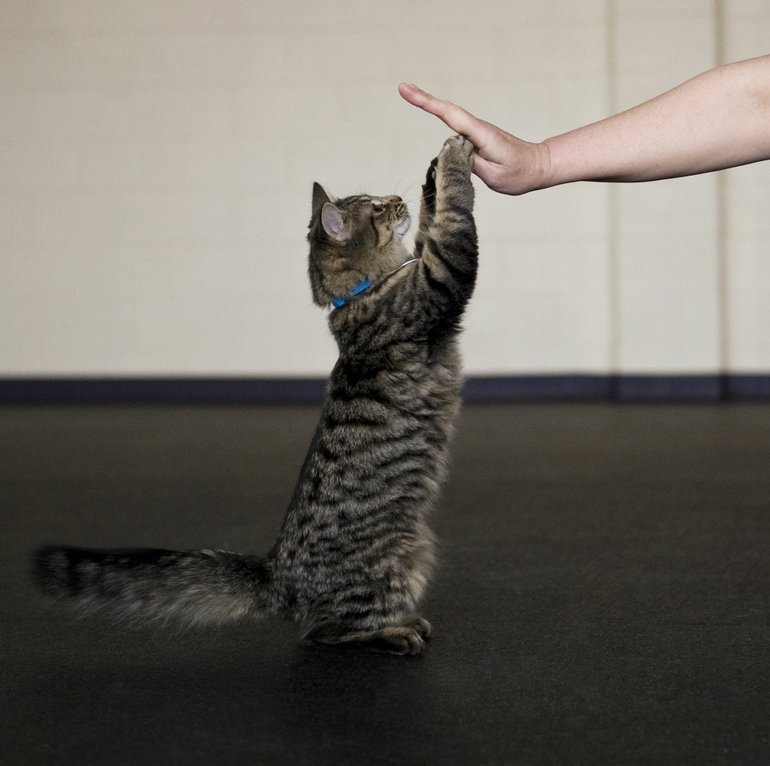People have low expectations of cats.
Sam Connelly tells of the time that she and her cat Storm observed a Canine Good Citizen test while they were waiting for their feline agility class to start.
“I’m watching the dogs and I commented to the evaluator, ‘My cat can do all that,’” said Connelly. “At the end she said, ‘Want to take a shot?’ like it was a big joke.”
To the evaluator’s surprise, Storm passed the test, successfully performing commands like sit, stay, come, down, and walking on a leash.
Storm is a cat who does some of these things for a living. He helps Connelly train lost pet search dogs in Maryland by hiding and waiting to be found.
But training cats isn’t just for professionals — human or feline. The Michigan Humane Society has a Pawsitive Start program that uses volunteers to train cats in their shelter in useful and fun behaviors like the high-five and walking into a carrier.
“A lot of people look kind of funny at us when we say we train the shelter cats,” says CJ Bentley of the humane society. Cats need more than just playtime outside the cage to be well-adjusted in the shelter environment, she says.
“It’s not just all about the physical, it’s the mental as well,” says Bentley. “To teach them to be able to solve problems on their own can reduce the stress. It gives them control over a situation.”
It’s not just shelter cats that need mental stimulation, though. Giving house cats jobs to do and skills to perform helps take the place of the experiences they’d have outdoors.
“The more skills you have, the more environmental enrichment you give them, the happier they’re going to be,” said Carrie Burhenn, veterinarian at the Feline Medical Clinic in Orchards.
Cats are as trainable as dogs, although their talents differ, Burhenn said. They can be taught to perform tasks such as fetching, coming when called and even navigating agility courses, jumping through hoops and running up ramps and through tunnels.
They are not so good for taking on brisk walks, though. “Cats are more exploring and seeking when walking, while dogs are interested in traveling. Cats wander,” Burhenn said.
Like dogs, cats respond well to clicker training, which positively reinforces behaviors, said Burhenn, a diplomate of the American Board of Veterinary Practitioners in feline medicine. When a cat does something he or she is asked to do, immediately click the clicker and provide a reward. Some cats respond to treats and others are more motivated by attention, Burhenn added.
Having your cat touch your hand with its nose on command is one of the easiest behaviors to train, says Melissa Chan, behavior specialist at the Houston SPCA. If you hold out your hand, most cats will naturally sniff it. Reward with a treat until the cat is doing it every time you present your hand. Then, start repeating a word like “touch” every time.
This trick can then be used to get the cat to move where you want it by placing your hand in the desired spot. “You can use it to ask them to get off the couch, or teach them to jump through a hoop by putting the hand on the other side of the hoop,” Chan says.
Another useful behavior is entering the cat carrier on their own. Sandy Lagreca, a volunteer at the Michigan Humane Society, says that this is great for both cats and people: “They go in without having to be picked up and shoved into the crate, which can be traumatic for the owner.”
All this requires is patience, repetition and a highly desired treat. Throw the treat into the crate (and if your cat is already suspicious of the carrier, step away). Let the cat go in, eat the treat, and leave, repeating until it’s completely comfortable going into the carrier. Then, start to close the door and leave the cat inside for increasingly longer intervals. Again, repeat until the cat is comfortable before you try to pick up the carrier.
Connelly says to keep training sessions short — she recommends no more than five minutes — and varied. “Teach something else when they get one thing right,” she says. “Cats get bored easily.”
In addition to the specific useful behaviors, Bentley says, training can help prevent problems by changing the terms of your relationship with your pet. “The animal learns, when I do this, you’re happy and I get a piece of food, I guess I should focus on making you happy,” she says. “Teaching our cats to successfully do what we like and get rewarded makes them more inclined to do what we like.”
And it’s also rewarding to see that your cat is capable of so much more than lying on the couch. Says Lagreca, “It’s fun to watch the progression and see the lights go on — when they make that connection it’s a magical moment.”
Columbian staff writer Mary Ann Albright contributed to this story.



